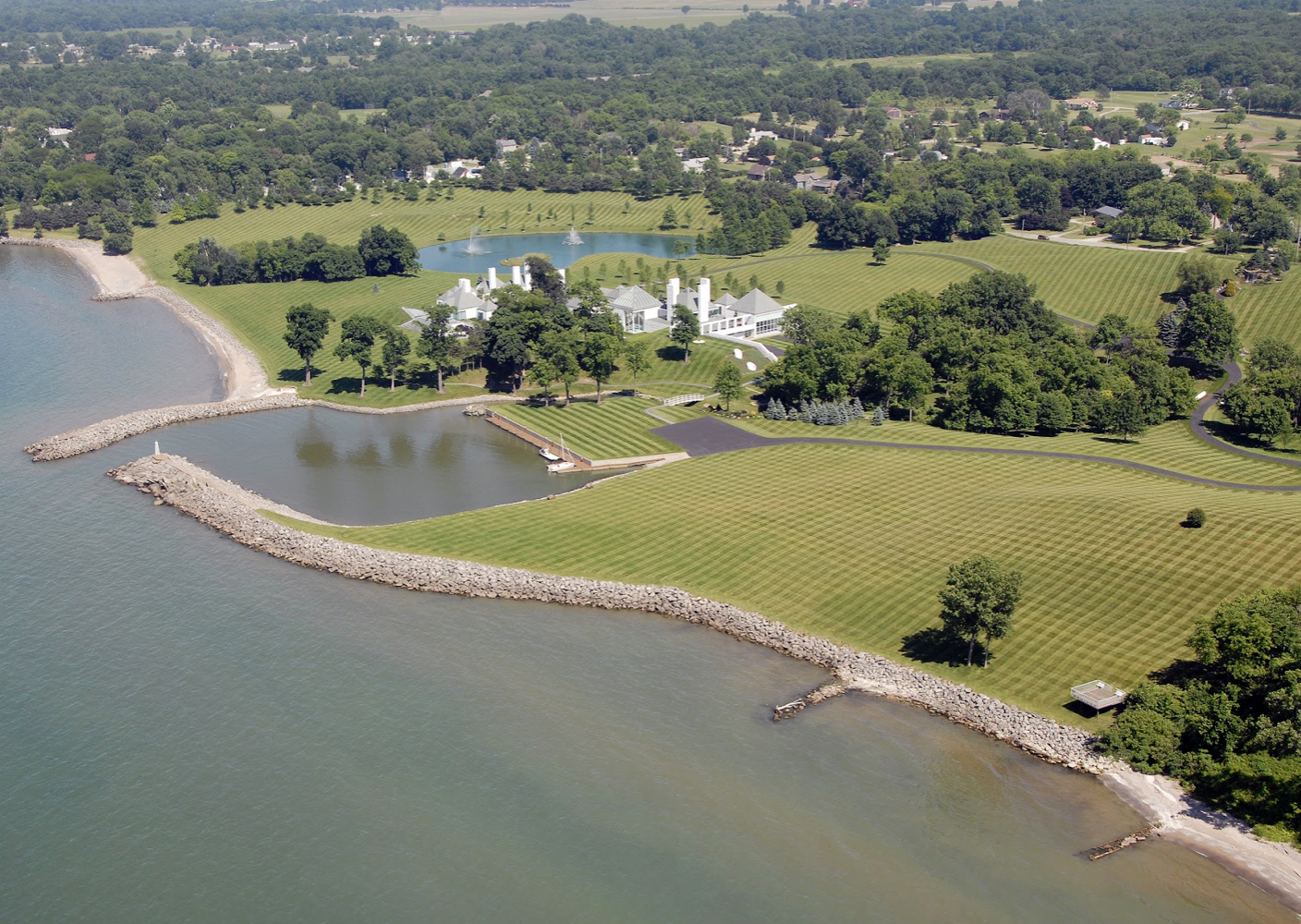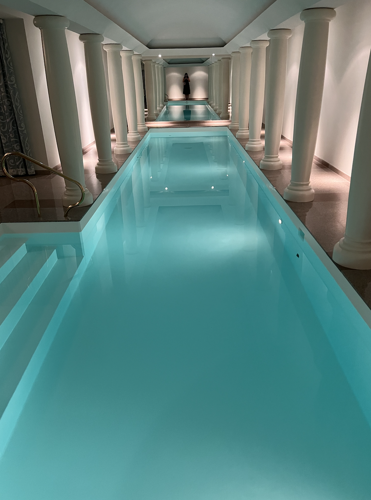Don Brown's Waterwood Estate in Vermilion, Ohio, to become Lake Erie Resort
Take a look inside this one-of-a-kind lakefront estate dreamt up by the inventor of the drop ceiling tile.

We'll be updating this story when resort specifics (including pricing) are available. Get the news delivered to your inbox by signing up for our free Splash newsletter. All we need is your name and email address. Promise! Click here to subscribe.
Since construction started at the home known to locals as “The Castle” on U.S. Route 6 in Vermilion, Ohio, in 1986, it has been shrouded in mystery.
The home, named Waterwood by its original owners, Don and Shirley Brown, was ostentatious — 38,000 square feet on a 60-acre piece of lakefront property. The Browns were private people, so details were scant while they lived there. The square footage and number of bedrooms weren’t even publicly available — and rumors filled the gap.
There were tales of a bomb shelter on the property (true, but Brown was trying to market and sell shelters after 9/11), a heliport, a turntable to rotate the car in the garage so nobody had to back out and a three-story lift platform that would rise to become an observation deck. (All true.)
There were also rumors of a labyrinthine system of tunnels and underground streets, attack dogs and armed guards patrolling the perimeters. (Those were exaggerations. There’s a modest crawlspace to maintain utilities, the Dobermans were family pets and, while there was on-site security, nobody was patrolling the beach carrying machine guns.)
Following the Browns’ tragic deaths in 2010 in a plane crash at the Lorain County Regional Airport, details started to come out as the property changed hands. Lake Erie Living magazine toured the property at the time and published this story.
Now, thanks to a new buyer — and a grand new plan — members of the general public could have access to the property. Well, some of it, anyway.
DeGeronimo Cos. bought the estate in 2020, and plans are being made to transform it. Construction is expected to begin later this summer for 26 townhouses and 60 condominiums. (DeGeronimo also bought 100 acres across Lake Road from the estate, also owned by the Brown family. Plans are as yet uncertain for that land.)
“One of the exciting parts of this project is being able to open up the estate to a wider audience so that the community can experience this wonderful property,” the company said in a statement.
When Brown set out to build the home in the 1980s, it would be the capstone of a lifetime of inventiveness.
Brown was born in Ontario, but his family moved to Detroit when he was a boy. He met his wife Shirley in high school, and after graduating from the Lawrence Institute of Technology, enlisted in the Army during World War II, where he fought in the Battle of the Bulge.
Upon his return home, Brown worked for Ford Motor Co. An inveterate tinkerer and inventor, he started Donn Products in 1954. His most notable — and most lucrative — achievement was patent No. 2,984,946, for accessible suspended ceiling construction. In simpler terms, Brown invented and popularized the use of drop ceilings.
The Browns raised three sons in a modest home in Westlake, but in 1986 — the same year Donn Products was sold for $168 million — started moving dirt on a 60-acre lakefront lot in Vermilion. It took three years just to get the land graded to Don Brown’s liking.
Brown then hired noted modernist architect Hugh Newell Jacobsen to design the house. Jacobsen had done renovations on the U.S. Capitol, and designed homes for Jacqueline Kennedy Onassis, Meryl Streep and King Hussein and Queen Noor of Jordan. (Another Ohio example of his work can be found on the banks of the Maumee River in northern Wood County, not far from Toledo.)
Jacobsen and Brown didn’t see eye to eye, and parted ways. Brown could be an exacting customer. His longtime assistant Terri Pabon said at one point, Brown was tired of delays in getting marble for the floor and bought the company to speed things up.
The exterior is molded concrete shaped to look like bricks; Brown had the molds destroyed afterward to ensure his home was one of a kind. Even Jacobsen, who didn’t set foot in the home until after Brown’s death, could admire Brown on some level. He called working for him “an event.” “Anyone can spend a lot of money, but to do it well is something else,” he said in a 2011 interview with the Columbus Dispatch.
The grounds are the equal of any country club — and just as scrupulously maintained. The property required four tractors to mow it regularly and has a massive filtration system to remove sand from lake water and use it for irrigation. The home initially employed a staff of dozens, but right now, Pabon says there are seven year-round maintenance workers on the grounds.
The home is divided into pods, with sliding doors opening and closing with the push of a button. The ground floor is separated into two areas — the family wing, with his-and-hers master bedrooms, and the guest wing. There are a total of 17 bedrooms, two full kitchens and kitchenettes and wet bars tucked away everywhere.
The pods on the main floor are connected with glass walkways, and glass is used in many of the rooms for walls — including a great room that’s almost entirely glass-walled, with a fireplace and chimney in each of the four walls holding up the roof (in all, there are nine fireplaces in the home). “Almost every room has a view,” Pabon says. In fact, one dining room has a turntable to ensure everyone gets a view of the lake.
The lower level is the home’s recreational wing, with a swimming pool, billiard and ping-pong tables and other play areas for the Browns’ grandchildren.

Already in his 60s when the home was built, Brown envisioned aging in place before the concept was popularized. The hallways were built wide enough to accommodate scooters (there’s a “garage” and charging station in one of the kitchens), there are elevators between floors, and Brown’s plans for the lower level included a doctor’s office, barbershop (with an antique barber chair) and potentially an apartment for a live-in caregiver.
“He thought of everything,” says Pabon, who is now the assistant estate/office manager.
After the Browns’ deaths, the home was eventually sold to their son, Ken. He died in 2018, and it went on the market again. The listings dispelled some of the rumors — and created others, like the one that intimated that the next buyer would be a celebrity looking for a Great Lakes hideaway. (Pabon recalls that the supposed celebrity was Tom Cruise, after someone misheard a conversation about Tom’s Cruz, a nearby limousine service.)
But the home was so large and expensive — when it went up for sale initially after the Browns’ death, at $19.5 million, it was the highest-priced house in the state — that it stayed on the market. DeGeronimo bought the estate in 2020, two years after Ken’s death.
“Like many that spend time in Vermilion, the DiGeronimos enjoyed boating by the property and admiring it from afar since 2010,” the company said in a statement. “With the incredible house, beautiful land, and some vision, they reached out to the real estate team.”

The townhomes and condos will be built on the property, and the house will be turned into a six-room boutique hotel with a reservation-only restaurant. The goal is to reuse it, while keeping the character that Brown tried so hard to implement.
“They really are keeping the memory of the Browns alive,” Pabon says.
Story:
Vince Guerrieri
2023 July/August






